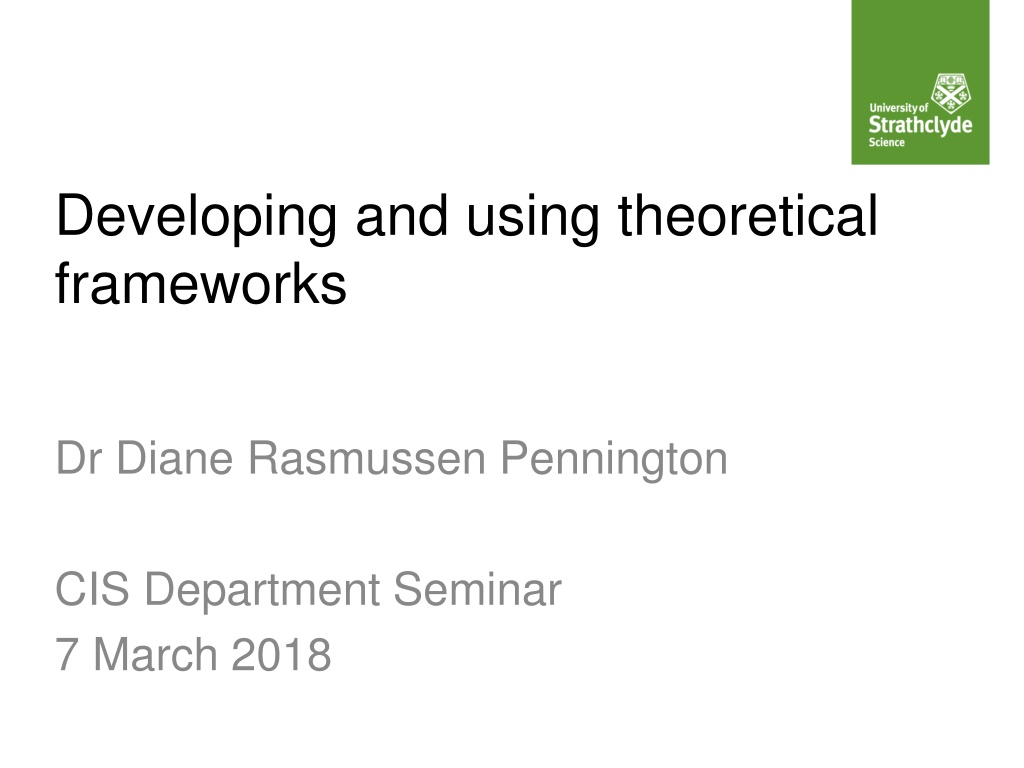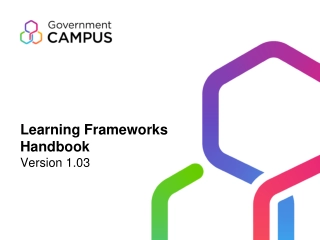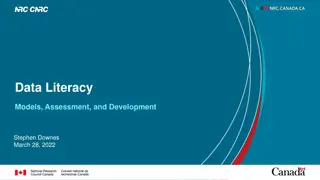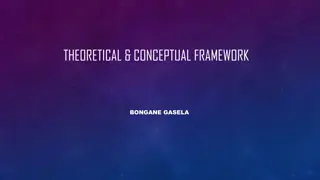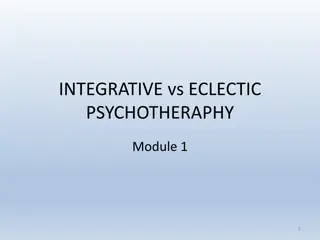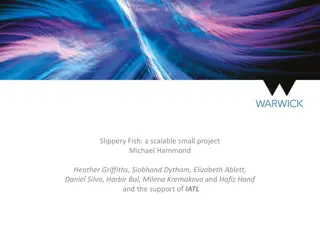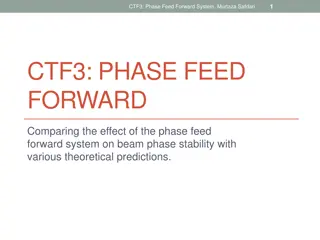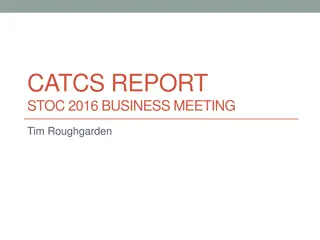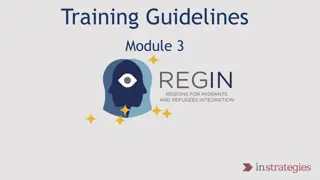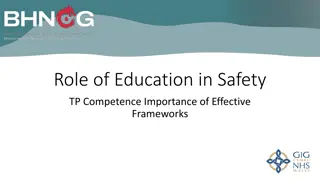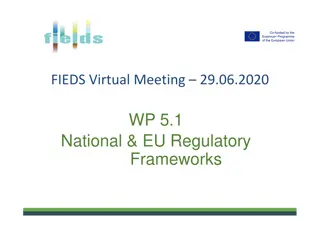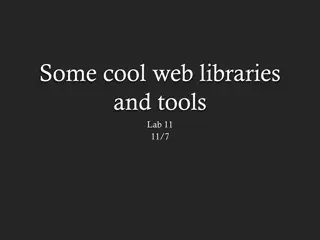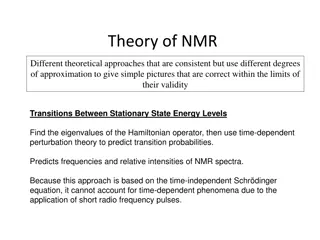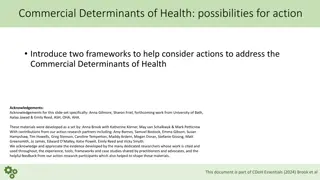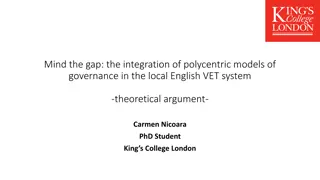Understanding and Developing Theoretical Frameworks for Research
Explore the concept of theoretical frameworks through examples and definitions, including how to integrate theories into empirical research. Learn about creating conceptual frameworks, the importance of arguments in research, and the criteria for rigorous research design. Discover the significance of linking research elements in the entire research process.
Download Presentation

Please find below an Image/Link to download the presentation.
The content on the website is provided AS IS for your information and personal use only. It may not be sold, licensed, or shared on other websites without obtaining consent from the author. Download presentation by click this link. If you encounter any issues during the download, it is possible that the publisher has removed the file from their server.
E N D
Presentation Transcript
Developing and using theoretical frameworks Dr Diane Rasmussen Pennington CIS Department Seminar 7 March 2018
Agenda Some core definitions and explanations Some examples of theories and models and how they can be integrated into empirical research Explorations into how to create a conceptual framework and all its parts Practice with developing and discussing your conceptual framework
Questions for you What are you studying? Why are you studying it? Who cares, and why do they care?
What is a framework? http://www.oxforddictionaries.com/definition/english/framework
What is a conceptual framework? (Ravitch & Riggan, 2017) It depends on who you ask! A graphic communicating the study s organisation or theoretical bases Conceptual frameworks and theoretical frameworks (we ll come back to these later) are the same thing A linking up of the entire research process (researchers interests, context, theory, methods, analysis, etc.) Some precise definitions follow
What is a conceptual framework? (Ravitch & Riggan, 2017, p. 5) [A]n argument about why the topic one wishes to study matters, and why the means proposed to study it are appropriate and rigorous.
What is an argument? (Ravitch & Riggan, 2017, p. 5) [A] conceptual framework is a series of sequenced, logical positions the purpose of which is to ground the study and convince readers of the study s importance and rigor. Arguments for why a study matters vary greatly in scale, depending on the audience.
What is appropriate and rigorous? (Ravitch & Riggan, 2017, p. 5) A conceptual framework should argue convincingly that: a) the research questions are an outgrowth of the argument for relevance; b) the research design maps onto the study goals, questions, and context(s); c) the data to be collected provide the researcher with the raw material needed to explore the research questions; and d) the analytic approach allows the researcher(s) to effectively address (if not always answer) those questions.
Elements of a conceptual framework (Ravitch & Riggan, 2017, p. 9)
Conceptual frameworks (Ravitch & Riggan, 2017, p. 12) Integrate many things: literature reviews theoretical frameworks topical research personal interests, goals, and experiences social standing and position to the research Can and should evolve throughout the course of your research based on what you learn from your data and your process Guide every stage of the research, from finding a problem to writing up
Other views on the conceptual framework A conceptual framework explains, either graphically or in narrative form, the main things to be studied the key factors, variables, or constructs and the presumed relationships among them. Frameworks can be simple or elaborate, commonsensical or theory driven, descriptive or casual. (Miles, Huberman, & Salda a, 2014, p. 20, as cited in Ravitch & Riggan, 2017, p. 6)
Other views on the conceptual framework [The] conceptual framework for your research is something that is constructed, not found. It incorporates pieces that are borrowed from elsewhere, but the structure, the overall coherence, is something that you build, not something that exists ready-made (Maxwell, 2013, p. 41, as cited in Ravitch & Riggan, 2017, p. 7) Combines researcher s experience and previously existing theory/research
Other views on the conceptual framework Gives us evidence that the study can potentially advance practice or policy by connecting to existing ones The conceptual framework reflects the important intellectual traditions that guide the study [I]dentifies gaps in what is known by critiquing previous research, by extending existing theory, or by pointing to practices and policies that are not working (Marshall & Rossman, 2011, p. 58, as cited in Ravitch & Riggan, 2017, p. 7)
What is a literature review? Finding out what has been written about a topic Learning what methods have been used to study the topic Thinking about how the existing literature connects to each other and to your work Reading and synthesising critically The written version should not be a book report e.g. Pennington said this. Hall said this. Tait said this It should not only include work that supports your own views on the topic It should evolve with your research Guidance for your conceptual framework; should include both topical research and theoretical frameworks (theories) For help with your literature review, read: Jesson, J. K., Matheson, L., & Lacey, F. M. (2011). Doing your literature review: Traditional and systematic techniques. Thousand Oaks, CA: Sage.
What is theory? Again, it depends on who you ask Attempts to explain a phenomenon by examining relationships between things Could include formal relationships, an idea of a researcher, beliefs about how to study something, etc. (Ravitch & Riggan, 2017) Critical theory: the stance that social structures (race, gender, etc.) influence our understandings of social phenomena
What is a theoretical framework? a considerably more focused, refined, and bounded integration of formal theory and topical research more broadly (Ravitch & Riggan, 2017, p. 12) Comprised of formal theories found or created by the researcher that support the conceptual framework
What is a theoretical framework? (Anfara, 2008) Any empirical or quasi-empirical theory of social and/or psychological processes that can be applied to the understanding of phenomena Incorrect notions abound that qualitative research is not guided by theory Qualitative research can also discover theory through grounded theory studies
What is a theoretical framework? (Anfara, 2008) The effects of a TF on research: To focus a study (sort data, write RQs, control bias, give structure to coding) Reveal/conceal meaning and understanding Situate research in the theory s language Reveal strengths and weaknesses; don t force the data to fit a certain theory The question remains, Is it possible to observe and describe what happens in natural settings without some theory to assist in naming what is happening?
Metatheories, theories, & models in LIS (Bates, 2005) Metatheory: theory concerned with theory, sometimes also called a paradigm Metatheories in LIS include: Historical Constructivist Constructionist or discourse-analytic Philosophical-analytic Critical theory Ethnographic Socio-cognitive Cognitive Bibliometric Physical Engineering User-centered design Evolutionary
Metatheories, theories, & models in LIS (Bates, 2005) Theory: the idea of a developed understanding, an explanation, for some phenomenon (p. 2) LIS doesn t have many theories of its own 72 listed in Theories of Information Behavior Model: a tentative proposed set of relationships, which can then be tested for validity (p. 3) Principle of Least Effort: people invest little in seeking information, preferring easy-to-use, accessible sources to sources of known high quality that are easy to use and/or less accessible (p. 4)
Example: Theory of Information Poverty (Chatman, 1996, pp. 197-198) 1. People who are defined as information poor perceive themselves to be devoid of any sources that might help them. 2. Information poverty is partially associated with class distinction. That is, the condition of information poverty is influenced by outsiders who withhold privileged access to information. 3. Information poverty is determined by self- protective behaviors which are used in response to social norms.
Example: Theory of Information Poverty (Chatman, 1996, pp. 197-198) 4. Both secrecy and deception are self- protecting mechanisms due to a sense of mistrust regarding the interest or ability of others to provide useful information. 5. A decision to risk exposure about our true problems is often not taken due to a perception that negative consequences outweigh benefits. 6. New knowledge will be selectively introduced into the information world of poor people. A condition that influences this process is the relevance of that information in response to everyday problems and concerns.
Theory of Information Poverty applied to a study of information seeking and use (Hasler, Ruthven, & Buchanan, 2014, p. 25) This study explores the use of online newsgroups and discussion groups by people in situations of information poverty ... Our work contributes to the study of both information seeking within the context of information poverty and the use of Internet groups as sources of information and support, bridging the two by exploring the manifestation of information poverty in this particular online setting.
Wilsons cognitive authority, extended into Neal and McKenzie s affective authority Cognitive authority: the extent to which users think they can trust the information they find; is it useful? Accurate? Current? (Wilson, 1983) Affective authority: the extent to which users think the information is subjectively appropriate, empathetic, emotionally supportive, and/or aesthetically pleasing (Neal & McKenzie, 2010) Original theory from LIS
Combining multiple models and theories to create and test a new model Basic Level Theory (Rosch et al, 1976)
Combining multiple models and theories to create and test a new model Pyramid model (J rgensen et al., 2001) A conceptual framework from electrical engineering and LIS
Combining multiple models and theories to create and test a new model Nine classes of image content (Burford, Briggs, & Eakins, 2003) from LIS
Combining multiple models and theories to create and test a new model Most popular tags of all time on Flickr (2008) http://web.archive.org/web/20080325030216/http://www.flickr.com/photos/tags/
Combining multiple models and theories to create and test a new model Our resulting model: Hierarchy for Online Photograph Representation (HOPR) (Lee & Neal, 2010) I. Abstract scene A. Emotion B. Opinion C. Transference D. Talk bubbles E. Assumption II. Abstract object III. Specific scene (etc. entire model can be viewed in the paper)
Critical theory in LIS (Leckie & Buschman, 2010) When LIS researchers use theory from other fields, it s not always based on a good understanding of its origins Greater use of critical theory in LIS: Will help us understand scholarly trends Examine information services/seeking/use more critically (the power of Google!) Is appropriate because we are a social field 23 critical theorists work applied to LIS in Critical theory for library and information science
Example of critical theory in LIS: Barthes semiology (Barthes, 1967) Denotation: a simple description of what the sign is picturing; easy to decode Anchorage: the text that accompanies the image and may clarify the denotation for viewers (called a relay-function) Connotation: more abstract levels of meaning in the image; requires cultural knowledge
Barthes semiology applied to image representation (Rasmussen Pennington, in press) What is the denotation of the image, the relay- function, and the connotation of the image?
How to create a conceptual framework: Questions to consider first What do I want to study? Who cares? What literature do I want to include, and when have I read enough? How do I know what kind of data to collect and how to analyse them? How does my own position and way of seeing the world shape the framing and execution of my research? How do I deal with surprises in the data or unexpected developments in the field? (Ravitch & Riggan, 2017, pp. 18-19)
How to create a conceptual framework (Ravitch & Riggan, 2017) Reflexive engagement Starting questions: why you are studying this, what your audience knows, influence of others, influence of theories Continuously self-examine and reflect on everything in every stage of the process Concept maps: visual or narrative display of a theory or a conceptual framework Research memos: structured reflection Research journal: unstructured, but reflective and critical Reflective writing video: https://www.youtube.com/watch?v=QoI67VeE3ds
How do you find a theoretical framework? (Anfara, 2008; Anfara & Mertz, 2015) Usually you must actively search for one Look at top journals that require explicitly stated TF sections in their articles Ask your supervisors Stay open to multiple perspectives May change during your study Look at other disciplines theories
In conclusion Working with conceptual frameworks and empirical research has never been an easy task (Chatman, 1996, p. 205). [T]he conceptual framework organizes and informs research; ensures a close alignment between topic, questions, and methods; and provides a mechanism for integrating and new data, findings, questions, and literature as a study evolves (Ravitch & Riggan, 2017, p. 193)
Your turn time to practice! Think about and write down: What your framework is right now for your current research What you think you need to do next to continue developing your framework Then share your thoughts in groups of 3-4 We ll discuss together at the end
References Anfara, V. A. (2008). Theoretical frameworks. In L. M. Given (Ed.), The Sage encyclopedia of qualitative research methods. Thousand Oaks, CA: Sage Publications. Anfara, V. A., & Mertz, N.T. (2015). Setting the stage. In V. A. Anfara & N. T. Mertz (Eds.), Theoretical frameworks in qualitative research (2nd ed.). Thousand Oaks, CA: Sage Publications. Bates, M. J. (2005). An introduction to metatheories, theories, and models. In K. E. Fisher, S. Erdelez, & L. E. F. McKechnie (Eds.), Theories of information behavior. Medford, NJ: Information Today. Barthes, R. (1967). Elements of semiology (A. Lavers & C. Smith, Trans.). New York, NY: Hill and Wang. Burford, B., Briggs, P., & Eakins, J. P. (2003). A taxonomy of the image: On the classification of content for image retrieval. Visual Communication, 2(2), 123-161. Chatman, E. A. (1996). The impoverished life-world of outsiders. Journal of the American Society for Information Science, 47(3), 193-206. Hasler, L., Ruthven, I., & Buchanan, S. (2014). Using internet groups in situations of information poverty: Topics and information needs. Journal of the Association for Information Science and Technology, 65(1), 25-36.
References J rgensen, C., Jaimes, A., Benitez, A. B., & Chang. (2001). A conceptual framework and empirical research for classifying visual descriptors. Journal of the American Society for Information Science and Technology, 52(11), 938- 947. Leckie, G., & Buschman, J. (2010). Introduction: The necessity for theoretically informed critique in library and information science (LIS). In G. J. Leckie, L. M. Given, & J. E. Buschman (Eds.), Critical theory for library and information science. Santa Barbara, CA: Libraries Unlimited. Lee, H-J, & Neal, D. (2010). A new model for semantic photograph description. Journal of Information Science, 36(5), 547-565. Neal, D., & McKenzie, P. (2011). Putting the pieces together: Endometriosis blogs, cognitive authority, and collaborative information behavior. Journal of the Medical Library Association, 99(2), 127-134. Rasmussen Pennington, D. (in press). Coding of non-text data. In A. Quan-Haase & L. Sloan (Eds.), The Sage handbook of social media research methods. Thousand Oaks, CA: Sage Publications. Ravitch, S. M., & Riggan, M. (2017). Reason & rigor: How conceptual frameworks guide research (2nd ed.) Thousand Oaks, CA: Sage Publications. Wilson, P. (1983). Second hand knowledge: An inquiry into cognitive authority. Westport, CT: Greenwood Press.
Thank you! Dr Diane Rasmussen Pennington diane.pennington@strath.ac.uk @infogamerist
